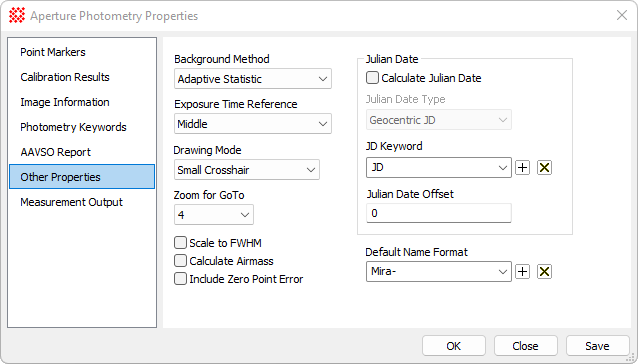To open the Other Properties page, click
![]() on the Aperture Photometry toolbar
and select the Other tab.
on the Aperture Photometry toolbar
and select the Other tab.
Other Properties (Photometry)
The Other Properties page is a member of the Aperture Photometry Properties dialog. This page has a number of important Properties that affect the aperture photometry process.
To open the Other Properties page, click
![]() on the Aperture Photometry toolbar
and select the Other tab.
on the Aperture Photometry toolbar
and select the Other tab.

|
Table Properties |
|
|
Background Method |
This list box chooses the statistical method for estimating the sky background from pixels in the annulus between the outer two apertures. Determining an accurate background is a key part of making accurate photometric measurements. Contaminating pixels from stars and bad pixels in the background annulus can impart a bias to the background estimate based on background pixels. Subtracting a biased background value from the object signal thus creates a biased measurement of the object’s brightness. Hence, it is best to choose a method appropriate to the degree of sample contamination. Mira provides several statistical methods for estimating the background value. These vary in their ability to compensate for contaminants in the background sample. From the most impacted to least impacted by contaminating pixels, these options are as follows: Mean Statistic: This is generally good for photometry in sparse fields where the background annulus is free from contaminating stars and bad pixels. Median Statistic: This method works well in fields where contaminants are a small fraction of pixels in the background annulus. However, it is not recommended for faint stars as the median yields an integer (whole-number) value for the sample, thus reducing the accuracy of the background measurement. As an extreme example, the median would truncate an actual background value of 105.486 to 105.0. Mode Statistic: This statistic is good for rejecting minor contaminants from the background annulus. Adaptive Estimator: This method uses a proprietary data rejection strategy to identify the true background within a heavily contaminated sample. Since this method rejects contaminating values from the statistical estimate, it also reduces the number of pixels used in computing the background. |
|
Exposure Time Reference |
This Properties selects the time stamp that goes into the Apphot Pane. The time of the observation is calculated from the date and time of observation from the image header and the exposure time, following the rule you select here. |
|
Drawing Mode |
This list box provides alternative ways of drawing the photometry markers on objects. |
|
Zoom for GoTo |
Specifies the zoom factor for the Go to Object menu command of the photometry measurements grid. |
|
Scale to FWHM |
If checked, the apertures are scaled to multiples of the FWHM of the image. This setting requires that the FWHM have been measured and is stored in the image header using the PSF-FWHM keyword . |
|
Calculate Airmass |
If checked, the airmass is calculated for each image using header keywords specified in the Photometry Keywords dialog. If not checked, the airmass for each image is taken from the AIRMASS keyword in the image header.
|
|
Include Zero Point Error |
Check this box to include the uncertainty (error)
of the photometric zero point in calculating the internal error of
the measurement. If checked, the values of Error and Error(T)
include the zero point error added using the root sum of squares.
If you change the check box after measurements are made, click
|
|
Julian Date |
This group controls the calculation and usage of Julian Date. |
|
Calculate Julian Date |
Check this box to calculate the Julian date from the image. Uncheck it to use the Julian Date value from the image header. If using the header value, set the Julian Date Keyword to the name of the header keyword containing the Julian Date. The Julian Date can also be calculated outside of photometry using the Calculate Julian Date command or a simple script (see the sample script, "Julian Date Function Test.lua"). |
|
Julian Date Type |
Select the type of Julian Date to be reported in the photometry table. The options are Heliocentric JD, Geocentric (normal) JD, and Modified Julian Date for both heliocentric and geocentric forms. The selection is listed in the Photometry Report; see Photometric Measurement Definitions. |
|
Julian Date Keyword |
This specifies the name of the Julian Date keyword in the image header when you are not calculating the Julian Date from the image properties. This property is used only if Calculate Julian Date is unchecked. This is a history list which can save new entries and recall old entries for the keyword name. |
|
Julian Date Offset |
Enter the value to subtract from Julian Date listed in the Apphot Measurement Pane. If desired, the number may be fractional, such as 2453000.5. After clicking[Apply] or [Save] the photometry report is updated with the new Julian Date including the offset. |
|
Default Name Format |
Enter the Prefix to use for the names of marked stars. A number is appended to this entry to make the default name for each marked object. However, the default name can be overridden using the Edit button on the toolbar. Use the [+] and [x] buttons to add or delete the currently displayed entry. |
Aperture Photometry Properties
Mira Pro x64 8.72 User's Guide, Copyright Ⓒ 2024 Mirametrics, Inc.
All Rights Reserved.